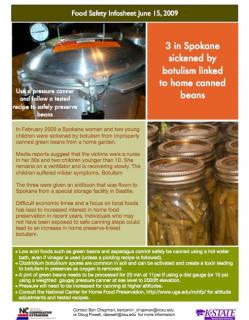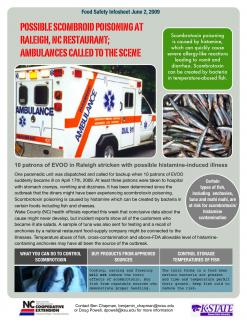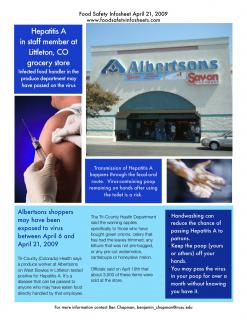Food Safety Infosheet Highlights:
– Cover your nose and mouth with a tissue when you cough or sneeze. Throw the tissue in the trash after you use it.
– If you are sick with flu-like symptoms, stay home for at least 24 hours after your fever is gone. Keep away from others as much as possible.
– Wash your hands often especially after you cough or sneeze. Alcohol-based hand cleaners are also effective, but are best used after proper handwashing.
Be ready for storms
Food Safety Infosheet Highlights:
-Hurricanes and storms can cause power outages and lead to food safety concerns
-Protect your food by being prepared
-Keep the refrigerator and freezer doors closed as much as possible to maintain the cold temperature
-You may safely re-freeze foods that still contain ice crystals or that have been kept at 41° F or below.
Memphis TN restaurant linked to Salmonella outbreak
Food Safety Infosheet Highlights:
– 20 patrons of A&R Barbecue ill, at least 2 hospitalized.
– As of August 10, Food that caused the outbreak is unknown.
– Outbreaks can result in restaurant closures, loss of wages and lawsuits.
Estimated 10,000 potentially exposed to Hepatitis A virus at Illinois McDonald’s
Food Safety Infosheet Highlights:
– If infected, you may spread the virus to others for 30 days before you get sick.
– Diners at the Illinois fast-food outlet from early June to July 13 may have been exposed to a virus that can cause liver disease.
– Handwashing can reduce the chance of passing Hepatitis A to patrons.
Clostridium Perfringens likely Cause of illness that sickened many in Myrtle Beach, SC.
Food Safety Infosheet Highlights:
– Improper cooling is suspected as the cause of the outbreak. It is not known how rapidly the food that the caterer prepared was cooled.
– Foods that have suffered temperature abuse often lead to Clostridium perfringens poisoning.
– Food can be briefly left out to cool, as long as it is refrigerated by the time it reaches 120℉. Use a thermometer to verify the temperature.
Harvey’s E. coli O157:H7 Outbreak Report Released
Food Safety Infosheet Highlights:
– 235 cases of E. coli O157:H7 were linked to a Harvey’s restaurant in North Bay, Ontario, Canada in October 2008
– Health authorities point to Spanish red onions as most likley source of the outbreak
– Poor sanitation of onion dicer may have prolonged the outbreak
– Equipment should be fully disassembled to allow for cleaning and sanitizing of hard to reach areas
Nestle Toll House cookie dough linked to E. coli O157:H7 outbreak
The newest food safety infosheet, a graphical one-page food safety-related story directed at food handlers, is now available at www.foodsafetyinfosheets.com
Food Safety Infosheet Highlights:
– Raw cookie dough linked to 66 illnesses in 29 states
– Cooking the recalled dough is not recommended as individuals may contaminate hands or other cooking surfaces.
– Always wash your hands after removing dough from package or placing on a cookie sheet.
– Clean and sanitize any utensil or surface after it has been in contact with raw cookie dough.
Food safety infosheets are created weekly and are posted in restaurants, retail stores, on farms and used in training throughout the world. If you have any infosheet topic requests, or photos, please contact Ben Chapman at benjamin_chapman@ncsu.edu
You can follow food safety infosheets stories and barfblog on twitter @benjaminchapman and @barfblog.
3 in Spokane sickened by botulism linked to home canned beans

The newest food safety infosheet, a graphical one-page food safety-related story directed at food handlers, is now available at www.foodsafetyinfosheets.com
-In February 2009 a Spokane woman and two young children were sickened by botulism from improperly canned green beans from a home garden.
-Use a pressure canner and follow a tested recipe to safely preserve beans.
-Clostridium botulinum spores are common in soil. The spores can be heat activated and turn into cells. The growing cells create a toxin leading to botulism in oxygen-free canned foods.
Food safety infosheets are created weekly and are posted in restaurants, retail stores, on farms and used in training throughout the world. If you have any infosheet topic requests, or photos, please contact Ben Chapman at benjamin_chapman@ncsu.edu
You can follow food safety infosheets stories and barfblog on twitter @benjaminchapman and @barfblog.
Possible Scombroid poisoning at Raleigh, NC restaurant; ambulances called to the scene

Food safety infosheet highlights:
– 10 patrons of EVOO in Raleigh stricken with possible histamine-induced illness
– Certain types of fish, including anchovies, tuna and mahi mahi, are at risk for scombrotoxin/ histamine contamination
– Cooking, canning and freezing will not reduce the toxic effects of scombrotoxin. Buy fish from reputable sources who demonstrate proper handling.
Hepatitis A in staff member at Littleton, CO grocery store

Food safety infosheet highlights:
-Albertsons shoppers may have been exposed to virus between April 6 and April 21, 2009.
-Infected food handler in the produce department may have passed on the virus.
-Transmission of Hepatitis A happens through the fecal-oral route.
-Virus-containing poop remaining on hands after using the toilet is a risk.
